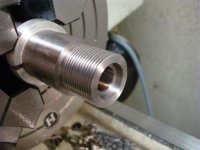What Mike Said
One of the things I absolutly hate is when one of those "squirrlely jig" in the bore spots is right where the throat is going form.
That is why I adadament about predrilling, indicating the throat area, taper boring the chamber to darned near finish, and then using the reamer as nothing more than a final finish tool. That way, you are minimizing any affect that a crooked bore will have on the performance of your reamer.
If your reamer has a tight, snug pilot, and it does encounter a spot in there that is not as true as it should be, something has to give. What will usually happen is the runnout at the pilot end will be transfered to the entire reamer body, and since a reamer will not bend, it will cause the situation you are encountering. Deflection is something that is inherant to using reamers.
Last Week End, I had a bunch of my buddies come over and watch me chamber some barrels for them. I just do this for my shooting friends out at Tomball. Here is the way I explain the proccess to them.
Barrels are not straight. If they were, all of this we go through would be a moot point. But since they are crooked, (not bent), you have to figure out a way to get three places running dead true in a crooked hole.
I call it the "two point indicate method". You decide what two points you are going to indicate dead true, then you machine the third point to match these. I declare the muzzle end, and the throat, as my starting points.
I set the barrel up, and get the muzzle and as far as I can reach into the chamber end bore running dead true. I then core out the chamber using a .400 drill. Ths allows me to reach up into the area where the throat will be. I then indiacate this dead true. (don't be surprised if there is as much as .002 difference in that length as what you indicated before). I then kick my compound off at a pre-determined mark on the degree dial, and taper bore the chamber to where the reamer fits in almost 1/2 way. I then, using the appropriate pilot, ream the chamber. I go a little deep, establishing the best chamber I can. Then, I check the chamber with the indicator, (sometimes it will show a couple of tenths), get it running dead true again, and procede with all of the other machining operations.
Notice, this is backwards from the way many do chambers. As a machinist, I feel that the most difficult part of chambering is establishing the finiest chamber possible, dead true with what the bullet first "sees" as the round is chambered. I then do all other operations, which will then run dead true with this chamber.
Of course, I do only Benchrest stuff, mostly my own. As I said, I do a few barrels for close friends, and I can take as much time as I want. I strive to make every chamber exactly the same, so I can use the brass from one Rifle in the next.
I also strive to do this for my friend's barrels as well. It is a real pleasure to be able to interchange any case, in any Rifle........jackie.



